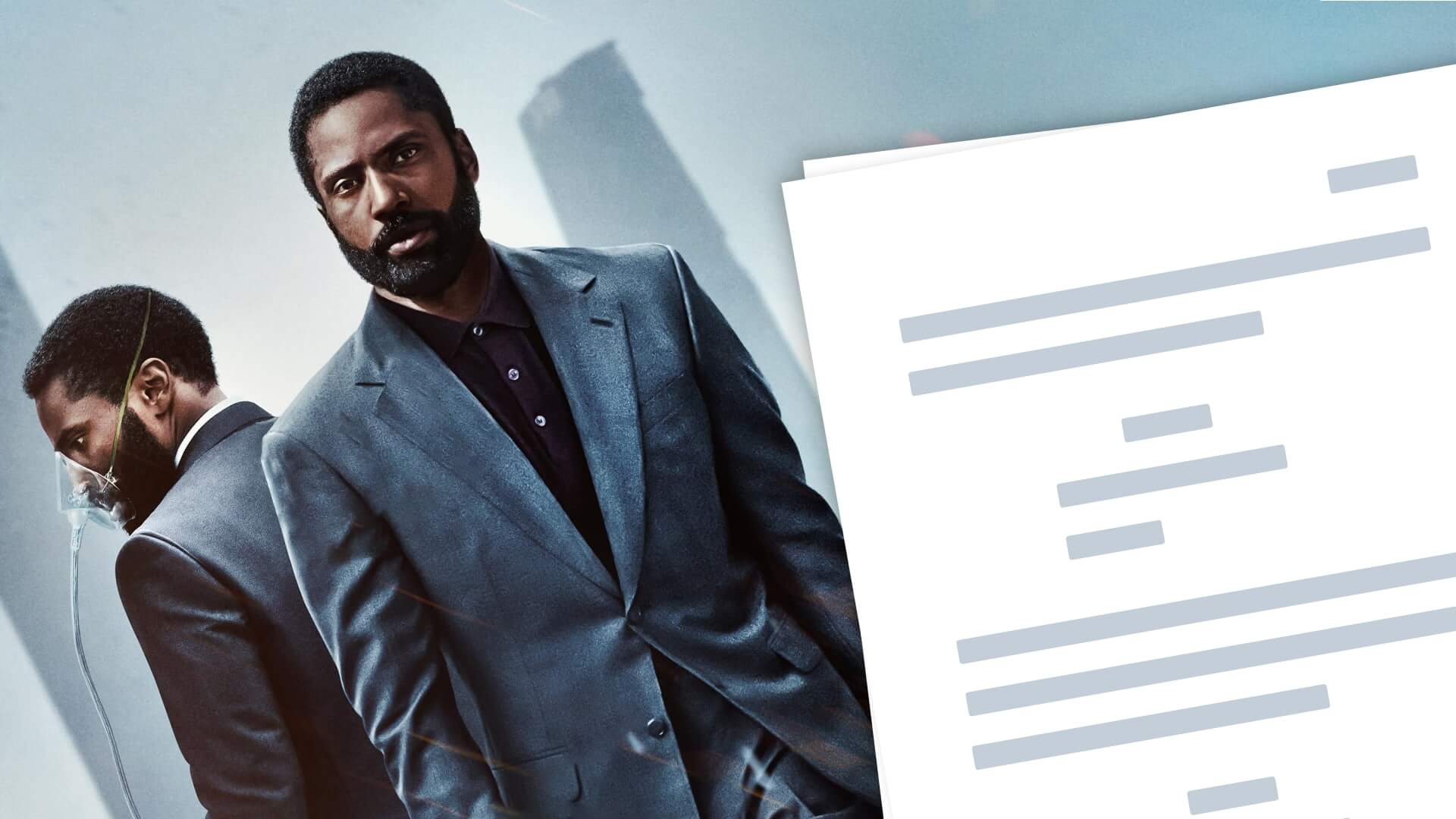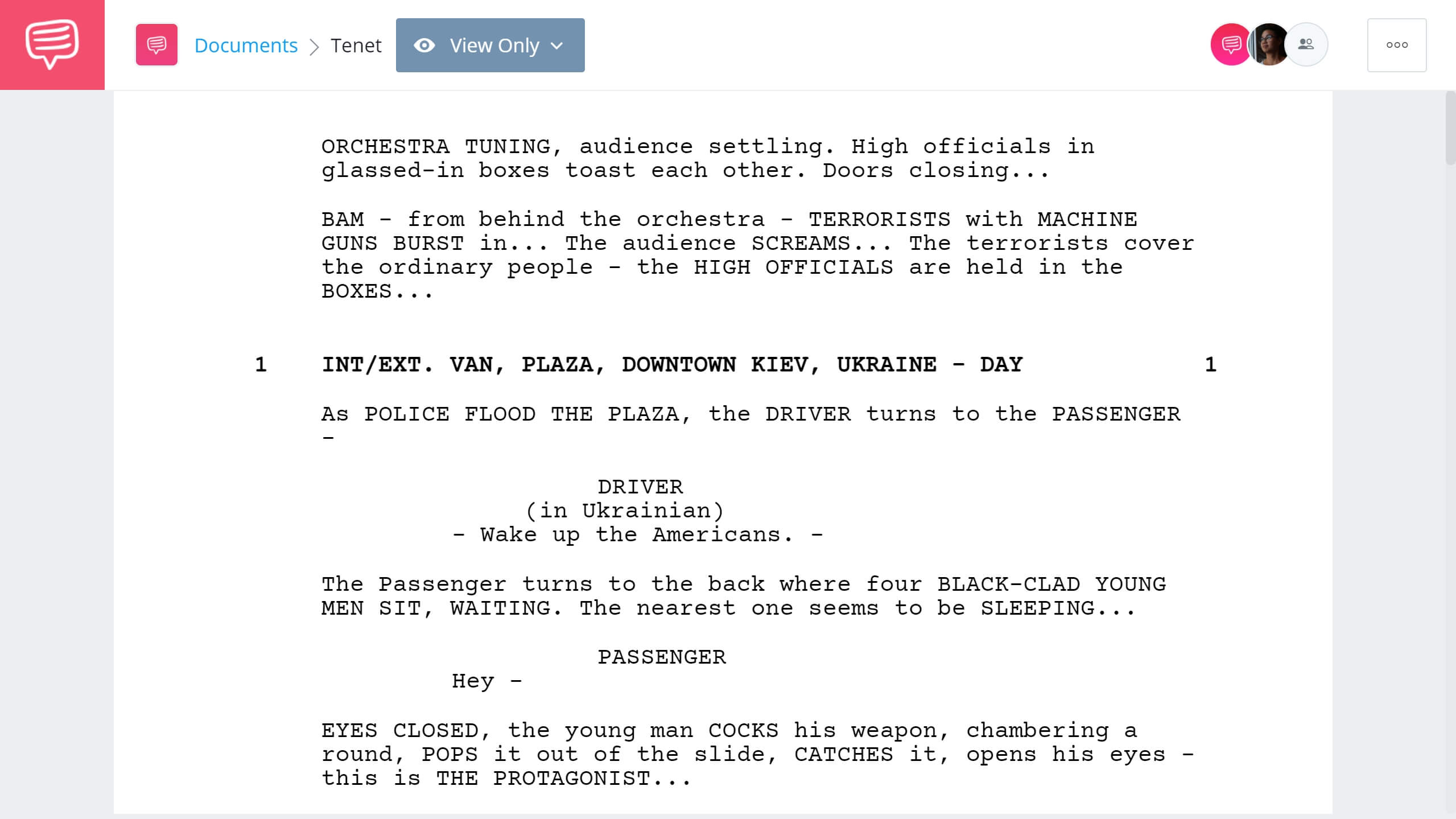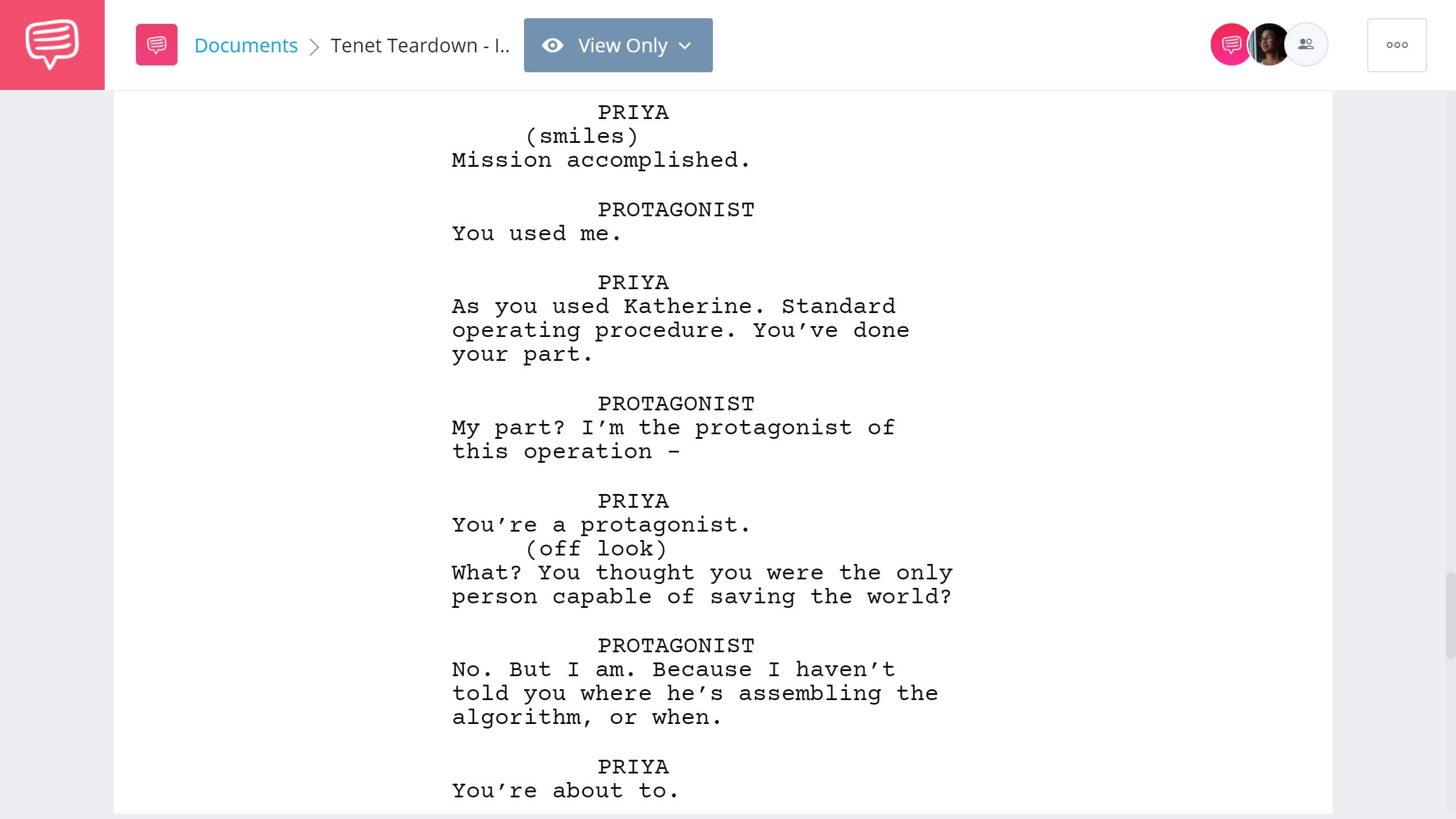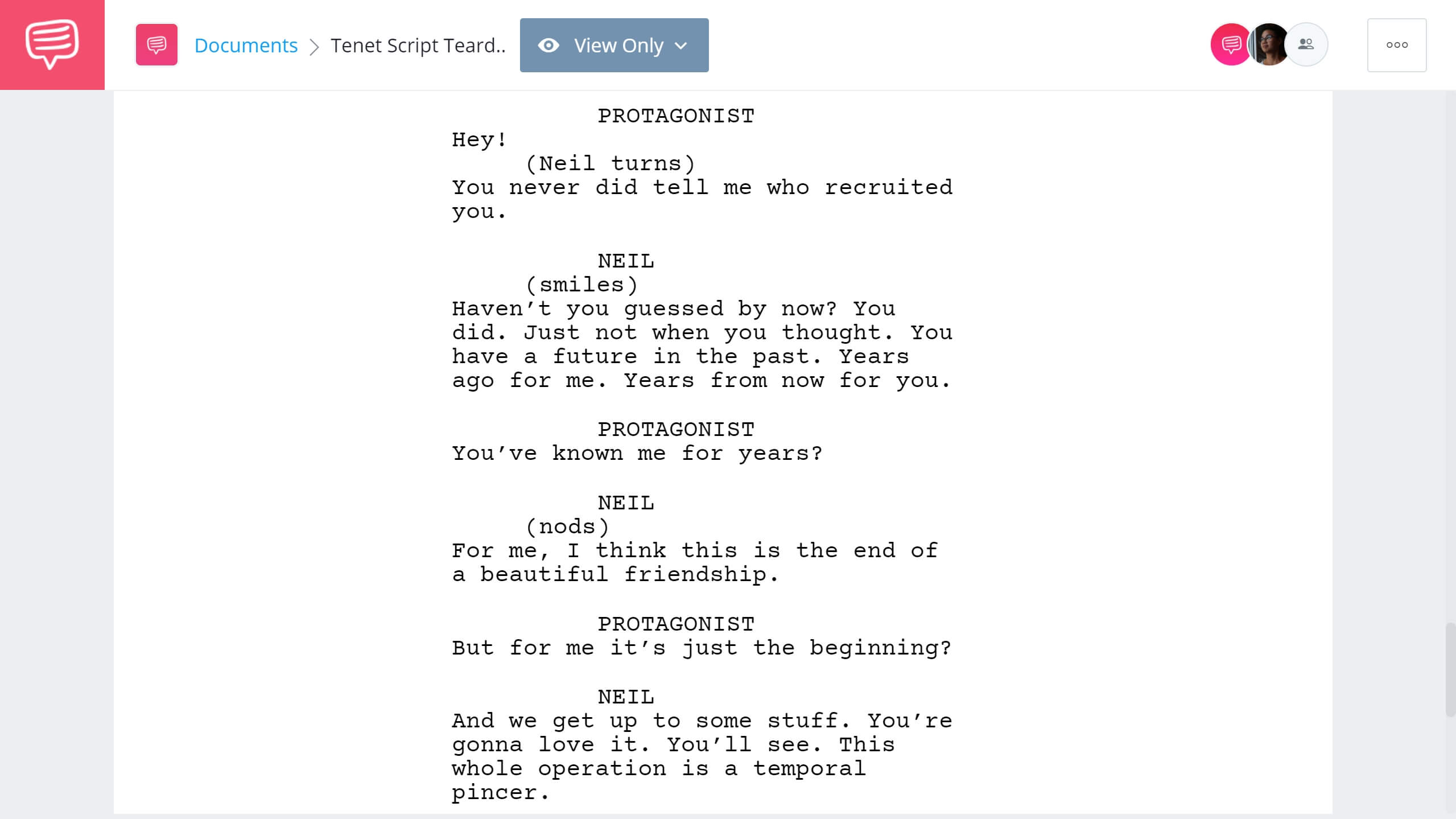Christopher Nolan’s Tenet screenplay is one of the most dense screenplays ever written, but fear not: we’re going to explain the Tenet screenplay by analyzing its key story beats and subversive narrative techniques. By the end, we’ll have a newfound knowledge of The Protagonist, reverse entropy, and the word tenet. Buckle up, we’re in for a doozy. Download the Tenet script PDF below and follow along!
WHO WROTE tenet SCRIPT?
Written by Christopher Nolan
Christopher Nolan is an award-winning British-American filmmaker. He’s perhaps best known for writing/directing films like Inception, Interstellar, and The Dark Knight Trilogy.
STORY BREAKDOWN
STRUCTURE OF THE TENET SCREENPLAY
Here is the story structure for the Tenet screenplay:
Note: There are a lot of intricacies in the Tenet screenplay. This summary is just that, a summary. We’ll break down the intricacies in further detail in the following sections.
Exposition
A CIA operative, known simply as the Protagonist, is captured during a raid in Kiev. The Protagonist chooses to kill himself rather than give up information – but he survives because the ploy was a test.
Inciting Incident
A scientist named Barbara informs The Protagonist that “World War III” is imminent. She displays how metallurgical anomalies have started to move in reverse – which could be remnants of a future war. Barbara tasks The Protagonist with learning more about “Tenet.”
Plot Point One
The Protagonist tracks down Priya – a munitions dealer in India – who tells him that Russian oligarch Andrei Sator has been developing inverted weapons.
Rising Action
The Protagonist meets with Kat, Sator's wife, and agrees to work with her. The Protagonist and associates Neil and Mahir crash a plane into a Freeport at the Oslo Airport. The Protagonist and Neil are then attacked by mysterious men clad in all-black who have the ability to use inverted bullets.
Midpoint
The Protagonist meets Sator on the Amalfi coast. Kat tries to kill Sator, but The Protagonist saves him because he needs more information about how reverse entropy works.
Plot Point Two
Sator agrees to work with The Protagonist on a plutonium thievery job, but continues to abuse Kat. On the day of the job, Sator forces The Protagonist to choose between the asset (which is revealed to be a mysterious object, not plutonium) and Kat’s life. The Protagonist chooses Kat – but they’re both captured and brought to an “entropy turnstile.” Sator shoots Kat, then Paramilitaries show up at Neil’s behest – but Sator escapes in pursuit of the mystery object.
Plot Build Up
The Protagonist learns that Sator is able to stay one step ahead of him because he uses “temporal pincers,” in which he sends one half of his team forward from the start of an important event, and the second half of his team back from its end. He trails the second team in order to see everything that happens.
Plot Point Three
The Protagonist goes through the turnstile so that he can reverse his actions – but he inadvertently gives Sator the mystery device. The Protagonist is then engulfed in flames, which gives him hypothermia due to the reverse entropy. Neil and paramilitary commander Ives rescue The Protagonist and head to Oslo in order to travel through the Freeport turnstile.
Plot Build Up Two
At the Oslo Freeport, The Protagonist and Neil confront the previous versions of themselves – and usher Kat into the turnstile to save her. Meanwhile, The Protagonist meets Priya again, two days before she initially tasked him with finding Sator. Priya tells The Protagonist that Sator is trying to reassemble the missing pieces of an inversion device from the future that was hidden in nine locations in the past.
Finale
The Protagonist learns Sator has a dead man’s switch that will trigger the algorithm and destroy the world when he dies. He and Neil hatch a plan to send Kat back in time to a moment where she let him feel loved, while they raid the location of the algorithm.
Climax
Two teams raid the algorithm site, one moving forward, one moving backward. At the same time, future Kat infiltrates Sator’s yacht and kills him. Neil reveals the entire plot has been a “pincer” designed by the Protagonist, then sacrifices himself for the good of humanity. The Protagonist and Ives escape with pieces of the algorithm, which they plan to hide in different times.
Denouement
The Protagonist “ties up loose ends” by killing Priya, then observes a happy Kat embracing her son.
Tenet Script Takeaway #1
The Tenet protagonist is a trope-walk
At just 148 pages, the Tenet screenplay somehow feels more dense than
War and Peace and Wealth of Nations. That’s because Tenet writer Christopher Nolan switches between contrivances and irony at a pace that makes the reader question if the plot is intended to be taken seriously, or as a commentary on storytelling tropes.
We imported the Tenet screenplay into StudioBinder’s screenwriting software to break down a scene where it’s difficult to diagnose Nolan’s narrative intentions. As you’re reading this scene, think about why Nolan chose to name his protagonist “The Protagonist” and why he has him refer to himself as the protagonist of the story.
Christopher Nolan Screenplay PDF • Read the Tenet Screenplay ‘I’m the Protagonist’ Scene
This may seem like an unimportant moment in the grand scheme of things, but it’s essential to understanding Tenet as a whole. Tenet is about its narrative as much as it is about a commentary on its narrative. If that sounds confusing, it’s because everything that has to do with Tenet is confusing.
When I say Tenet is a narrative and a commentary on its narrative, I mean to say this: Nolan seems conscious of genre trappings, storytelling conventions, and character tropes at every step of the way. But sometimes, he gets lost in the middle-ground between story and commentary.
Naming the protagonist “The Protagonist” is a very purposeful thing to do. Essentially, it breaks the fourth wall and tells us that what we’re “in on” the thing we’re watching; except we’re not, because ultimately, The Protagonist is a vessel, not a character.
The Protagonist is a conduit for us to experience the story, much like a static video game protagonist. Through him, we experience story developments in real-time. We’re not given any information about The Protagonist’s background, life story, or interests outside of the main narrative.
Because of this, on one hand, we can say The Protagonist lacks character depth and character development. I wouldn’t argue it, you wouldn’t argue it. Even Nolan himself probably wouldn’t argue it. On the other hand, if we say The Protagonist is a conduit, or a reflexive character, then it doesn’t matter much if he lacks depth and development.
Ultimately, The Protagonist works as a meta-reference to the already meta-nature of the story. Here’s a great fan-cut of some of The Protagonist’s best moments from the film.
Tenet Script to Screen • The Protagonist in Tenet
If you’re considering writing a screenplay, it may be best to stick to tried and true narrative tenets, like “give your character backstory” and “give your character depth.”
But if you want to generate frenetic action like Nolan, consider using montages. Montages can help expedite exposition and build pace/energy to your story. For more on how Nolan uniquely uses montages, check out our video below.
How Christopher Nolan Elevates the Movie Montage • Subscribe on YouTube
Chris Nolan uses montages in Tenet to mirror action sequences across time and space. As we continue to break down the Tenet script, think about how his use of montages, or consequently the lack thereof, influences the dramatic pacing of the story.
Tenet Script Takeaway #2
The Tenet dialogue is expository
I suppose it’s ironic to say the dialogue in Tenet is expository, or intended to “explain” because it often leaves more questions than answers. I’ve torn down most of Nolan’s screenplays (which you can find in the StudioBinder script archives) but none are quite as confounding as Tenet.
First, let me say this: Nolan is a great screenwriter. Even when he relies heavily on exposition, like he does in the Inception screenplay and Interstellar screenplay, he finds ways to keep the dialogue natural. But in Tenet, the dialogue often feels forced.
This next scene is a perfect example of forced dialogue. As you’re reading, think about why this scene doesn’t work – yet also why the information relayed in it had to be in the story.
Christopher Nolan Screenplay PDF • Read the ‘Crosby Scene’ in the Tenet Screenplay
This is an obscenely unnatural exchange of dialogue. Okay, now read it again, but cross out all of Crosby’s lines. Notice anything? Everything the Protagonist says is a question. And they’re not even good questions; when Crosby says the location is abandoned, the Protagonist replies, “abandoned?”
Not “why was it abandoned?” or “what happened there?” No, simply “abandoned?” This scene is especially irksome because it feels like it exists solely for the sake of exposition.
Now, there are some alternative opinions on this scene. One is that Crosby is actually Ives, who was recruited by the Protagonist to carry out the raid at the end of the movie. If you subscribe to this opinion, then the scene makes a lot more sense. The YouTube channel Heavy Spoilers has a great video on this theory (and other Tenet theories).
Tenet Explained: The Best Theories by Heavy Spoilers
All of this analysis begs the question though: does it matter if Crosby is Ives? If he is, it certainly makes the scene more viable in a plot sense, but the dialogue is still expository.
Tenet Script Takeaway #3
Tenet characters are pawns
Here’s an interesting way to think of Tenet: it is a chess match. If you know the rules, you understand what’s happening when watching the events unfold. The problem is that it’s impossible to know the rules of Tenet without seeing it first. But on a second viewing (or third or fifth or tenth), you’ll start to make sense of the various machinations of the game.
Everyone in Tenet is a pawn; even the Protagonist. In fact, the Protagonist is his own pawn. How neat! But if there’s one character who seems to know more than any other, it’s Neil. There’s no doubt about it: Neil is the best developed character in Tenet.
Throughout the script, we see Neil conceal vital information under the (albeit smart) guise of “ignorance is bliss.” Other times, we see Neil hint at unrequited knowledge, like when he suggests The Protagonist doesn’t drink on the job, and when he saves The Protagonist from killing the alternate version of himself. These moments are excellent demonstrations of character/plot nuance; they add to the tension and mystery of the story in an organic and worthwhile way.
Ultimately, Neil reveals he does have more knowledge than the other characters in the story (even Sator and Priya). It’s a poignant moment in a script that’s otherwise devoid of emotional beats.
Let’s review the scene below. As you’re reading, think about how this moment serves as the emotional climax of the story.
Christopher Nolan Screenplay PDF • Read the Tenet Ending
Here, we see Neil sacrifice himself for the sake of humanity. We also relate to The Protagonist, who understands it’s the end of a friendship he doesn’t truly understand. All in all, it’s an emotional moment that wouldn’t be possible if not for the convoluted plot.
And if you subscribe to the pervading theory that Neil is actually Kat’s son Max, the scene adds even more dramatic weight. This next video from Insider breaks down the ending of Tenet and how it relates to Neil in further detail.
Tenet Script to Screen • Tenet Ending Explained by Insider
What do you think? Is Neil truly Kat’s son Max? Is Tenet a closed loop from the first page? And ultimately: is Tenet one of Christopher Nolan’s best movies? Let us know in the comments below.
Related Posts
UP NEXT
Read and download more scripts
Tenet is a mind-bending screenplay that demands rigorous analysis. If you want to continue reading screenplays, we have similar titles like Inception, Interstellar, and The Dark Knight in our screenplay database. Browse and download PDFs for all of our scripts as you read, write and practice your craft to become the next great screenwriter.





great analysis ! i have a question, is it the original screenplay written by Nolan, or a screenplay written by someone after the movie
TENET is an awesome experience. Thanks for this analysis. Thanks for being StudioBinder.